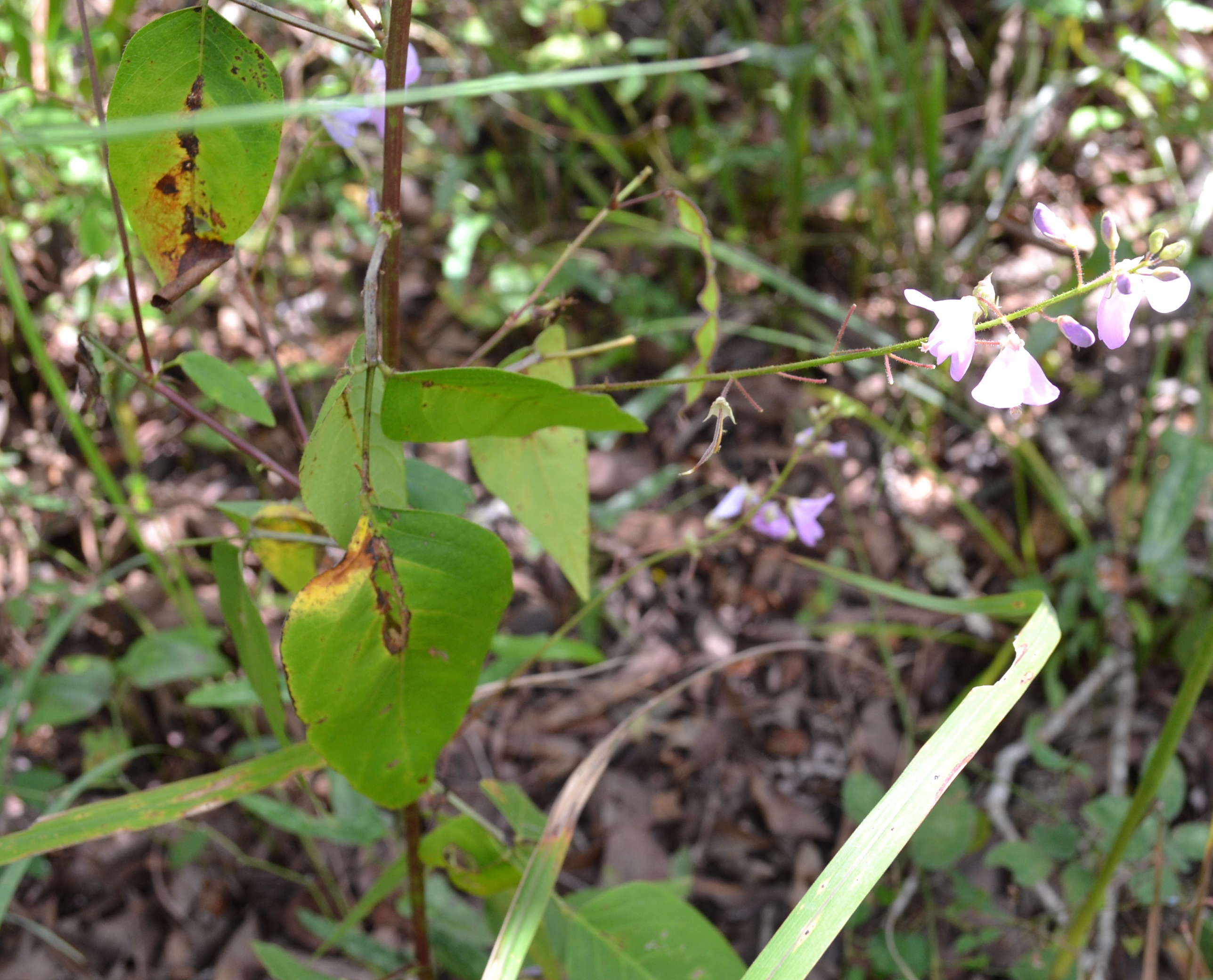Desmodium floridanum
| Desmodium floridanum | |
|---|---|

| |
| Photo taken by Kevin Robertson | |
| Scientific classification | |
| Kingdom: | Plantae |
| Division: | Magnoliophyta - Flowering plants |
| Class: | Magnoliopsida – Dicotyledons |
| Order: | Fabales |
| Family: | Fabaceae ⁄ Leguminosae |
| Genus: | Desmodium |
| Species: | D. floridanum |
| Binomial name | |
| Desmodium floridanum Chapm. | |

| |
| Natural range of Desmodium floridanum from USDA NRCS Plants Database. | |
Common name: Florida ticktrefoil
Contents
Taxonomic notes
Synonym: Meibomia rhombifolia Vail
Description
Generally, the Desmodium genus species are "annual or perennial herbs, shrubs or small trees. Leaves 1-5 foliolate, pinnately 3-foliolate in ours or rarely the uppermost or lowermost 1-foliolate; leaflets entire, usually stipellate; stipules caduceus to persistent, ovate to subulate, foliaceous to setaceous, often striate. Inflorescence terminal and from the upper axils, paniculate or occasionally racemose; pedicel of each papilionaceous flower subtended by a secondary bract or bractlet, the cluster of 1-few flowers subtended by a primary bract. Calyx slightly to conspicuously 2-lipped, the upper lip scarcely bifid, the lower lip 3-dentate; petals pink, roseate, purple, bluish or white; stamens monadelphous or more commonly diadelphous and then 9 and 1. Legume a stipitate loment, the segments 2-many or rarely solitary, usually flattened and densely uncinated-pubescent, separating into 1-seeded, indehiscent segments."[1]
Specifically, the D. floridanum species are"erect perennial; stem to 5 dm tall, mostly uncinatepubescent, occasionally interspersed with pilose trichomes. Leaves mostly 1-foliolate below, 3-foliolate above. Terminal leaflets rhombic to deltoid or ovate, 4-9 cm long, uncinulate puberlent and softly pilose beneath; stipules persistent, lance-ovate to ovate-attenuate, 4-10 mm long; stipels persistent. Inflorescence racemose to paniculate, uncinulate-puberulent; pedicels 4.5-8 mm long. Calyx uncinulate-puberulent and pilose on lobes and upper tube; petals purplish, 6-7.5 mm long; stamens diadelphous. Loment of 3-5 deltoid segments, each 6-7 mm long, 4-5 mm broad, curved on upper suture and broadly rounded below, uncinulate-puberulent on both sides and sutures; stipe 1.5-4 mm long, shorter than the calyx lobes and stamina remnants."[1]
Distribution
AL, FL, GA, SC.
Ecology
Habitat
It is found in upland longleaf and shortleaf pine native communities (Ultisols), pine-oak flatwoods, sand pine-oak scrub (Entisols), longleaf and slash pine flatwoods (Spodosols), edges of hardwood forests (FSU Herbarium). It thrives in frequently burned areas. It occurs in open areas and semi-shaded areas. It can occur in areas with recent soil disturbance and old-field pine forests (FSU Herbarium). It occurs on sandy to loamy soils from xeric to moist conditions (FSU Herbarium).
Associated species include Desmodium viridiflorum, D.strictum, D. glabellum, Tephrosia, Eryngium yuccifolium, Aristida, Pluchea , Longleaf pine, slash pine, and turkey oak (FSU Herbarium).
Phenology
It flowers from April to October. It fruits from May to October (FSU Herbarium).
Conservation and Management
Cultivation and restoration
Photo Gallery
References and notes
Florida State University Robert K. Godfrey Herbarium database. URL: http://herbarium.bio.fsu.edu. Last accessed: June 2014. Collectors: Loran C. Anderson, R. K. Godfrey, R. Kral, V. Sullivan, J. Wooten, Grady W. Reinert, J. N. Triplett, Jr., John B. Nelson, G. Knight, Gwynn W. Ramsey, Richard Mitchell, A. F. Clewell, C. Jackson, H. Roth, V Craig, Bill Boothe, and Marcia Boothe. States and Counties: Florida: Bay, Citrus, Columbia, Gadsden, Franklin, Gulf, Jackson, Jefferson, Lafayette, Leon, Levy. Madison, Putnam, Suwannee, and Wakulla. Georgia: Baker, Charlton, McIntosh and Thomas.
Radford, Albert E., Harry E. Ahles, and C. Ritchie Bell. Manual of the Vascular Flora of the Carolinas. 1964, 1968. The University of North Carolina Press. 604-12. Print.